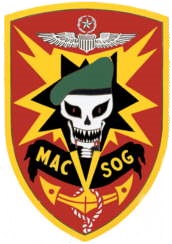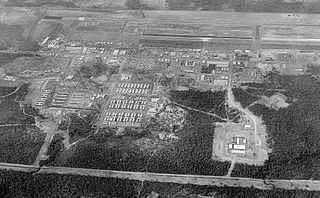
The Republic of China Armed Forces are the armed forces of the Republic of China (ROC) that once ruled Mainland China and now currently restricted to its territorial jurisdictions of Taiwan, Penghu, Kinmen and Matsu Islands. They consist of the Army, Navy, Air Force and Military Police Force. The military is under the civilian control of the Ministry of National Defense, a cabinet-level agency overseen by the Legislative Yuan.

Air America was an American passenger and cargo airline established in 1946 and covertly owned and operated by the Central Intelligence Agency (CIA) from 1950 to 1976. It supplied and supported covert operations in Southeast Asia during the Vietnam War, including providing support for drug smuggling in Laos.
A Military Assistance Advisory Group (MAAG) is a designation for a group of United States military advisors sent to other countries to assist in the training of conventional armed forces and facilitate military aid. Although numerous MAAGs operated around the world throughout the 1940s–1970s, including in Yugoslavia after 1951, and to the Ethiopian Armed Forces, the most famous MAAGs were those active in South Vietnam, Cambodia, Laos, and Thailand, before and during the Vietnam War. Records held by the National Archives and Records Administration detail the activities of numerous assistance advisory groups.

The Vietnam War involved the People's Army of Vietnam (PAVN) or North Vietnamese Army (NVA), National Liberation Front for South Vietnam (NLF) or Viet Cong (VC), and the armed forces of the People's Liberation Army (PLA), Army of the Republic of Vietnam (ARVN), United States Armed Forces, Republic of Korea Armed Forces, Armed Forces of the Philippines, Royal Thai Armed Forces, Australian Defence Force, and New Zealand Defence Force, with a variety of irregular troops.

USS Maddox (DD-731), was an Allen M. Sumner-class destroyer. It was named after Captain William A. T. Maddox of the United States Marine Corps.

Operation Commando Hunt was a covert U.S. Seventh Air Force and U.S. Navy Task Force 77 aerial interdiction campaign that took place during the Vietnam War. The operation began on 15 November 1968 and ended on 29 March 1972. The objective of the campaign was to prevent the transit of People's Army of Vietnam (PAVN) personnel and supplies on the logistical corridor known as the Ho Chi Minh Trail that ran from southwestern North Vietnam through the southeastern portion of the Kingdom of Laos and into South Vietnam.

The Pacific Air Forces (PACAF) is a Major Command (MAJCOM) of the United States Air Force and is also the air component command of the United States Indo-Pacific Command (USINDOPACOM). PACAF is headquartered at the Hickam AFB portion of Joint Base Pearl Harbor–Hickam, Hawaii, and is one of two USAF MAJCOMs assigned outside the Continental United States, the other being the United States Air Forces in Europe – Air Forces Africa. Over the past sixty-five plus years, PACAF has been engaged in combat during the Korean and Vietnam Wars and Operations Desert Storm, Southern Watch, Northern Watch, Enduring Freedom and Iraqi Freedom.

The Republic of China Marine Corps is the amphibious arm of the Republic of China Navy (ROCN) responsible for amphibious warfare, counter-landing and reinforcement of the areas under the jurisdiction of the Republic of China (ROC), including the island of Taiwan, Kinmen, and the Matsu Islands, and defense of ROCN facilities, also functioning as a rapid reaction force and a strategic reserve capable of amphibious assaults.

The Republic of China Air Force is the military aviation branch of the Republic of China Armed Forces, based in Taiwan since 1947. The ROCAF was founded in 1920 by the Kuomintang. While its historical name is sometimes used especially in domestic circles, it is not used as often internationally due to the current ambiguous political status of Taiwan and to avoid confusion with the People's Liberation Army Air Force of the People's Republic of China (PRC).

Military Assistance Command, Vietnam – Studies and Observations Group (MACV-SOG) was a highly classified, multi-service United States special operations unit which conducted covert unconventional warfare operations before and during the Vietnam War.

The Black Cat Squadron, formally the 35th Squadron, was a squadron of the Republic of China Air Force that flew the U-2 surveillance plane out of Taoyuan Air Base in northern Taiwan, from 1961 to 1974. 26 ROCAF pilots successfully completed U-2 training in the US and flew 220 operational missions, with about half over the People's Republic of China.

Tiger stripe is the name of a group of camouflage patterns developed for close-range use in dense jungle during jungle warfare by the South Vietnamese Armed Forces and adopted in late 1962 to early 1963 by US Special Forces during the Vietnam War. During and after the Vietnam War, the pattern was adopted by several other Asian countries. It derives its name from its resemblance to a tiger's stripes and were simply called "tigers." It features narrow stripes that look like brush-strokes of green and brown, and broader brush-strokes of black printed over a lighter shade of olive or khaki. The brush-strokes interlock rather than overlap, as in French Lizard pattern (TAP47) from which it apparently derives.

Tan Son Nhut Air Base (1955–1975) was a Republic of Vietnam Air Force (RVNAF) facility. It was located near the city of Saigon in southern Vietnam. The United States used it as a major base during the Vietnam War (1959–1975), stationing Army, Air Force, Navy, and Marine units there. Following the Fall of Saigon, it was taken over as a Vietnam People's Air Force (VPAF) facility and remains in use today.
The United States Air Force (USAF) deployed combat aircraft to Thailand from 1960 to 1975 during the Vietnam War. Today, US military units train with other Asian militaries in Thailand. Royal Thai Air Force Bases are an important element in the Pentagon's "forward positioning" strategy.

The Nakhon Phanom Royal Thai Navy Base (NKP), formerly Nakhon Phanom Royal Thai Air Force Base, is a Royal Thai Navy facility used for riverine patrols along the Mekong River. It is approximately 587 km (365 mi) northeast of Bangkok, 14.5 km (9.0 mi) west of Nakhon Phanom city in Nakhon Phanom Province in the northeastern region of Thailand, and 411 km (255 mi) from Hanoi in Vietnam. The Mekong River is NKP's border with Laos. The airfield at NKP is jointly used as a civilian airport.

Operation Barrel Roll was a covert U.S. Air Force 2nd Air Division and U.S. Navy Task Force 77, interdiction and close air support campaign conducted in the Kingdom of Laos between 14 December 1964 and 29 March 1973 concurrent with the Vietnam War. The operation resulted in 260 million bombs being dropped on Laos.
The Many Flags campaign was an initiative by United States President Lyndon Johnson to get U.S. allies in Asia and the Pacific to participate in the Vietnam War in support of South Vietnam. While it served a military purpose, the program was also a propaganda effort by Johnson to enlist Free World forces in the Cold War against communism. The U.S. supported the Allied forces through direct monetary aid, military contracts, logistic aid, and various forms of economic compensation.

The attack on USNS Card was a Viet Cong (VC) operation during the Vietnam War. It took place in the port of Saigon in the early hours of 2 May 1964, and was mounted by commandos from the 65th Special Operations Group.

VA-216, nicknamed the Black Diamonds, was an Attack Squadron of the US Navy. It was established on 30 March 1955, and disestablished 15 years later on 1 August 1970.

The Vietnam War involved many countries across the world. North Vietnam received support from the Eastern Bloc, while South Vietnam was generally supported by nations of the Western Bloc.
















